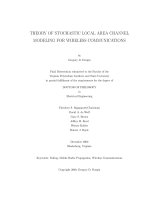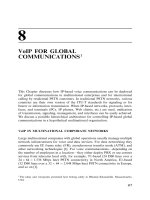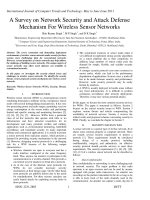Tdd - cdma for wireless communications
Bạn đang xem bản rút gọn của tài liệu. Xem và tải ngay bản đầy đủ của tài liệu tại đây (2.37 MB, 191 trang )
TEAMFLY
Team-Fly
®
TDD-CDMA for Wireless Communications
For a listing of recent titles in the Artech House Universal Personal Communications
Series, turn to the back of this book.
TDD-CDMA for Wireless Communications
Riaz Esmailzadeh
Masao Nakagawa
Artech House
Boston • London
www.artechhouse.com
Library of Congress Cataloging-in-Publication Data
Esmailzadeh, Riaz.
TDD-CDMA for wireless communications/Riaz Esmailzadeh, Masao Nakagawa.
p. cm. — (Artech House universal personal communications series)
Includes bibliographical references and index.
ISBN 1-58053-371-X (alk. paper)
1. Code division multiple access. I. Nakagawa, M. (Masao) II. Title. III. Series.
TK5103.452 .E66 2002
621.3845’6—dc21 2002032680
British Library Cataloguing in Publication Data
Esmailzadeh, Riaz
TDD-CDMA for wireless communications.—
(Artech House universal personal communications series)
1. Time division multiple access 2. Code division multiple access 3. Wireless
communication systems
I. Title II. Nakagawa, Masao
621.3’845
ISBN 1-58053-371-X
Cover design by Yekaterina Ratner
Regarding the copyrighted 3GPP figures in Chapter 7, 3GPP TSs and TRs are the property of
ARIB, CWTS, ETSI, T1, TTA, and TTC, who jointly own the copyright in them. They are
subject to further modifications and are therefore provided to you “as is” for information pur-
poses only. Further use is strictly prohibited.
© 2003 ARTECH HOUSE, INC.
685 Canton Street
Norwood, MA 02062
All rights reserved. Printed and bound in the United States of America. No part of this book
may be reproduced or utilized in any form or by any means, electronic or mechanical, including
photocopying, recording, or by any information storage and retrieval system, without permis
-
sion in writing from the publisher.
All terms mentioned in this book that are known to be trademarks or service marks have
been appropriately capitalized. Artech House cannot attest to the accuracy of this information.
Use of a term in this book should not be regarded as affecting the validity of any trademark or
service mark.
International Standard Book Number: ISBN 1-58053-371-X
Library of Congress Catalog Card Number: 2002032680
10987654321
Contents
Preface
xi
Acknowledgments
xiii
1 Introduction 1
1.1 Mobile Communications 2
1.2 TDD Systems 4
1.3 Spread Spectrum Communications 7
References 9
2
Mobile Radio Communications 11
2.1 Radio Communication System 11
2.2 Mobile Channel Characteristics 13
2.2.1 Power Control 18
2.2.2 Diversity Combining Techniques 19
2.2.3 Diversity Combining Methods 21
2.3 Spread Spectrum Communications 24
v
2.3.1 FH-SS 25
2.3.2 DS-SS 27
2.4 CDMA Communications 31
2.4.1 Uplink of a CDMA System 33
2.5 System Configuration 35
2.5.1 Public Systems 35
2.5.2 Private and Ad Hoc Systems 36
2.6 Summary 36
References 36
3
TDD Transmission 39
3.1 TDD System 39
3.2 Synchronous Transmission 44
3.3 Why TDD? 46
3.3.1 Reciprocity 47
3.3.2 Impulse Response Estimation 50
3.4 CDMA Group Transmission: TDD 51
3.5 Summary 52
References 52
4
Power Control in TDD-CDMA Systems 55
4.1 Uplink Power Control in TDD 58
4.1.1 Imperfect Channel Estimation 64
4.2 Downlink Power Control 66
4.3 Power Control in Multipath Diversity 67
4.3.1 Imperfect Channel Estimation 71
4.4 Summary 73
References 73
5
Pre-Rake Diversity Combining 75
5.1 Introduction 76
vi
TDD-CDMA for Wireless Communications
5.2 Multipath Channel Model 77
5.3 The Rake Combination 78
5.4 The Pre-Rake Combination 79
5.5 Theoretical Analyses 81
5.5.1 SNR 81
5.5.2 BER 84
5.6 TDD-CDMA System with Pre-Rake 85
5.7 Performance Analysis of the Pre-Rake TDD-CDMA 87
5.7.1 Self-Interference 88
5.7.2 Multiple-Access Interference 89
5.8 Performance Analysis of the Rake TDD-CDMA 92
5.8.1 Self-Interference 92
5.8.2 Multiple-Access Interference 92
5.9 Numerical Results and Discussion 94
5.10 Summary 96
References 96
6
System Capacity in TDD-CDMA Systems 99
6.1 Downlink Capacity 101
6.2 Uplink Capacity 102
6.3 Orthogonal Transmission 103
6.3.1 Downlink 103
6.3.2 Uplink 104
6.4 Directional and Adaptive Array Antennas 109
6.5 Multiuser Detection 112
6.5.1 Uplink Interference Cancellation 113
6.5.2 Uplink Joint Detection 114
6.5.3 Downlink Joint Predistortion 117
6.6 Summary 120
References 120
Contents
vii
7 TDD-Based CDMA Standards for Public Systems 123
7.1 Historical Background 123
7.2 TD-CDMA Standard 126
7.2.1 Layer 3: Radio Resource Control 127
7.2.2 Layer 2: Data Link Layer 127
7.2.3 Layer 1: Physical Layer 131
7.3 TD-SCMDA Standard 136
7.3.1 Physical Layer 137
7.3.2 Channel Coding 138
7.3.3 Interleaving 138
7.3.4 Radio Frame Segmentation and Rate Matching 138
7.3.5 TrCH Multiplexing 138
7.3.6 PhCH and Subframe Segmentation 138
7.3.7 Frame and Slot Structure 140
7.3.8 Modulation and Spreading 141
7.4 Summary 141
7.5 TD-CDMA Test System 142
7.5.1 Elements and Configuration of Experimental
Equipment 142
7.5.2 Laboratory Experiments 143
7.5.3 Field Trial 146
7.5.4 Summary 148
References 149
8
TDD Spread Spectrum–Based Private Systems 151
8.1 Bluetooth Ad Hoc System 151
8.1.1 Bluetooth Air Interface 152
8.1.2 Ad Hoc Networking 153
8.1.3 Why TDD? 155
8.2 Spread Spectrum Cordless Telephone 156
8.2.1 System Configuration 156
8.2.2 TDD Operation 158
viii
TDD-CDMA for Wireless Communications
8.3 Summary 158
References 159
9
TDD and Fourth-Generation Systems 161
9.1 Subscriber and Traffic Growth 161
9.2 Transmission and Network Technology 163
9.3 Conclusion 164
References 165
About the Authors 167
Index 169
Contents
ix
.
TEAMFLY
Team-Fly
®
Preface
This is a graduate-level book on the time division duplex (TDD) mode of code
division multiple access (CDMA) technology for mobile communications. Its
purpose is to familiarize the reader with the specific technologies related to
the TDD mode of CDMA communications. In the TDD mode, transmis-
sion and reception to and from a user are carried out in the same frequency
band, with transmission/reception switching at specific time slots. The TDD
mode, as opposed to the more widely known and used frequency division
duplex mode, has been used in non-CDMA mobile communications systems
such as DECT and PHS. It has now become an integral part of the wideband
CDMA (WCDMA) standards.
The reader is assumed to have a general knowledge of cellular mobile
communications. However, a compact introduction to the subject matter in
each chapter is expected to assist the beginner engineer to comprehend the
subject matter. A comprehensive list of conference and journal papers in the
references has also been provided for the reader who wants to gain a deeper
insight into the TDD-CDMA technology.
The motivation for this book has been the lack of specific literature on
the TDD-CDMA technology. While much of this material has been avail
-
able in the form of individual papers, a book dealing specifically with the
details of TDD-CDMA has not been available. Many books on CDMA have
dedicated a chapter to TDD. However, these have not been comprehensive
enough to explain what makes the TDD technology unique and valuable in
specific applications. As the TDD mode becomes a major part of third-
xi
generation standards, and as it promises to become even more prominent in
fourth-generation standards, it is appropriate to dedicate an entire book to
TDD to discuss the specific techniques that are only possible in a TDD
mode of operation.
We authors have the distinction of being associated with TDD-CDMA
from the very beginning. Our work with TDD-CDMA started when Riaz
Esmailzadeh came to Japan in 1990 to start his Ph.D. studies at Nakagawa
Laboratory at Keio University. His work performed during 1991 to 1994
was the first to propose TDD-CDMA and was to form the basis for future
TDD-CDMA activities and standards. Our collaboration continued long
after the studies were completed. Dr. Esmailzadeh became involved with the
WCDMA standardization, and a number of students at the Nakagawa Labo
-
ratory continued working with the TDD mode. We have seen it become a
part of the WCDMA standards, as well as integral technology for some pri-
vate spread spectrum systems. We have further promoted the technology to
see that it is positively considered for the fourth-generation standards. These
systems are targeted for implementation in the latter part of this decade.
xii
TDD-CDMA for Wireless Communications
Acknowledgments
We authors were encouraged to undertake this project by Mr. Kambiz
Homayounfar, the CEO of the Genista Corporation, where Dr. Esmailzadeh
was previously employed. His constant encouragement and support was an
important factor in the accomplishment of this work. We are indebted to Dr.
Mario Luoni, Dr. Tadashi Matsumoto, Dr. Essam Sourour, Dr. Anand R.
Prasad, Dr. Jun Du, and Dr. Terence Percival, who, along with many others,
have encouraged, supported, and assisted us through the many years we have
been working on this topic. Our editors at Artech House were exact and
helpful. Their skills in project management prevented this book from drag-
ging on and ensured its timely publication. We are further grateful to Mat-
sushita Communication Industrial Co., Ltd. for permitting us to publish in
part their paper on their TDD-CDMA system and experimental results. The
permission by the IEICE, IEEE, and 3GPP to reproduce some figures from
copyrighted material is hereby acknowledged and appreciated.
Most of all, we are grateful to our families who endured our preoccupa
-
tion with this project over and above other work-related activities. This book
is dedicated to them.
xiii
.
1
Introduction
The telecommunications industry was born almost 150 years ago with the
establishment of the first Morse transmission line between Washington,
D.C., and Baltimore, Maryland, in the United States. Some 32 years later, in
1876, Alexander Graham Bell demonstrated the first voice communication
device, which he called a telephone. The telephone was an overnight success;
by early 1881 the first American Bell company annual report showed that
almost all major North American cities already had telephone exchanges,
with a total of 132,692 telephone subscribers [1]. This explosive rate of
growth was maintained until almost every home in North America had a
telephone.
The first wireless communication was not to take place for another 30
years, and not until the first decade of the twentieth century. However, while
wired communication soon became inexpensive and found its way into
almost every home, the wireless and mobile means of communication were
costly and did not become popular. Instead, they found their applications in
broadcasting, intercontinental and satellite communications, and mobile
military, police, and emergency communications. Whereas the wired com
-
munications explosion was instantaneous, the wireless revolution did not
occur until the 1980s.
1
1.1 Mobile Communications
The mobile communications revolution took place for a number of reasons.
Foremost among these was the decrease in the cost of mobile telephony
because of the advent of transistors and high-speed signal processing. The
cost of mobile devices and services was further reduced because of the econo
-
mies of scale, as more and more subscribers found the services affordable.
The price for a mobile phone has dropped to less than $100 from more than
$2,500 since 1983, in large part due to increases in manufacturing volume.
Moreover, many operators have subsidized the cost of mobile phones, reduc
-
ing the initial cost to the user to zero.
As a result, wireless/mobile communications was the fastest growing
field in the electronics and telecommunications industry during the 1990s,
becoming the largest consumer product industry in history—even bigger
than the PC that emerged at the same time. The explosive growth in demand
for mobile and cordless voice and data communication services caused sig-
nificant reductions in system costs that in turn fueled further demand. To
keep up with such demand, the technology had to evolve constantly, result-
ing in the development of numerous systems, some of which are presently in
service or in the implementation phase; some have even come into service,
had a short life span, and have already been phased out.
The demography of mobile users and their demands have also changed
greatly. The initial customers were mostly business users, who for the
most part required wide-area connectivity and who were not greatly con-
cerned with the communications quality or size and cost of the mobile
units. Nowadays, it is a commodity product used by all people. Users now
demand small, light, and inexpensive mobile units with low service charges.
Moreover, users now demand other services in addition to the telephony
services, such as data and video communications. The growing demand has
meant that more efficient bandwidth utilization methods have had to be
developed, and that more bandwidth be allocated for mobile communica
-
tions services.
Research since the early 1990s has been geared toward finding solu
-
tions to the challenges mentioned, such as enabling higher transmission
rates, better bandwidth usage efficiency, and service provision diversity. Fur
-
ther challenges have been reducing the size and cost of the handheld devices
and improving the quality of service.
The third generation of mobile communications systems promises to
provide these and a global service such that you can always be reached, wher
-
ever you are in the world, using the very same phone [2]. Now that the
2 TDD-CDMA for Wireless Communications
technology has delivered the dream, questions are being raised about whether
it is possible to avoid being reached.
Mobile systems and services have been classified in a number of differ
-
ent ways. Figure 1.1 shows some of these services to illustrate the emergence
of new technologies [3–5]. The figures gives approximates of the time at
which they appeared on the market or are expected to appear. Cellular
mobile communication systems are broadly divided into the first, second,
and third generations of services, based on whether the system is analog or
digital, and voice or multimedia, that is, based on the extent to which the
services they provide differ. The first generation of mobile systems has
already been phased out by and large and the second-generation systems have
been in operation now for some 10 years and are expected to be replaced by
or evolve into the third-generation systems, which are presently being rolled
out.
A general trend can be observed in the utilized multiple-access schemes:
from frequency-division multiple access (FDMA) to time-division multiple
access (TDMA) and code-division multiple access (CDMA). TDMA and
CDMA developments were generally made in response to the above-
mentioned challenges, particularly better frequency utilization efficiency and
service provision flexibility as compared with FDMA [6, 7]. They were also
capable of accommodating multirate services, one of the main requirements
of future multimedia mobile communications.
Introduction 3
Multimedia
1
980
1
990
2
000
2
0
1
0
Year
~2.4 Kbps ~64 Kbps ~2
Mbps
~20
Mbps
1G 2G 3G 4G
Narrowband Era Wideband Era Broadband Era
Service type
Voice
Wireless
Internet
mobile
system?
IMT-2000
Analog
AMPS
TACS
NTT
Digital
IS95
IS136
GSM
PDC
Figure 1.1 Generations of mobile communications. (
Source:
[5], 2001 IEICE.)
Figure 1.2 illustrates the difference between these three access tech
-
niques. In FDMA systems, a user is assigned a portion of a frequency band
over which it transmits its information and which it keeps for the duration of
the connection. In TDMA systems, a frequency band is shared between sev
-
eral users, who in turn use the channel for transmission (or reception) of
information at clearly defined time intervals. In a CDMA system, many users
use the same frequency band, all the time, and are distinguished at the receiver
by a unique spreading code.
1.2 TDD Systems
An emerging trend can also be detected in the duplex mode of operation of
mobile services. The time-division duplex (TDD) schemes seem to be gradu-
ally gaining favor, at the expense of the more broadly used frequency-division
duplex (FDD) mode. The TDD systems are appearing in the low-power end
of the domain, where simplicity and low cost are major concerns.
As shown in Figure 1.3 most of the lower power, small-area cellular sys-
tems (usually provided in microcells, with little round-trip propagation
delays on the order of a few microseconds) of the second generation used
TDD as their duplex mode. In Europe the Digital European Cordless Tele-
phone (DECT) standard is based on TDD-TDMA [8], in Japan also, the
Personal Handyphone System (PHS) is based on TDD-TDMA [3]. For the
third-generation systems, two TDD-CDMA standards have already been
adopted: time-division/code-division multiple access (TD-CDMA) as part of
the 3GPP standards, and time-division/synchronous code-division multiple
access (TD- SCDMA) in China. These systems are expected to be rolled out
in the 2002–2003 time frame. Furthermore, TDD-CDMA is increasingly
the focus of research and is being experimented with in combination with
multicarrier CDMA for fourth-generation devices [9].
The main difference between the two modes, as shown in Figure 1.4, is
that duplex transmission is carried in alternate time slots for the TDD mode
in the same frequency channel, whereas FDD uses two separate channels for
continuous duplex transmission. In fact, all half-duplex systems, such as
amateur radio, are TDD systems. The communications parties alternately
talk and listen or send and receive information, using a manual switch. In
“modern” TDD systems, the switching between the uplink and downlink is
standardized and automatic.
One of the advantages of using TDD over FDD is its design simplicity.
This is because only one set of electronics (filters, oscillators, and so forth) is
4 TDD-CDMA for Wireless Communications
Introduction 5
Frequency
Power Level
Time
.
.
.
Frequency
Time
Channel
N
.
.
.
Channel 3
Channel 2
Channel 1
Power Level
Frequency
Power Level
Time
Channel
N
Channel 3
Channel 2
Channel 1
.
.
.
FDMA
TDMA
CDMA
Channel
N
Channel 3
Channel 2
Channel 1
Time Slots
Figure 1.2
FDMA versus TDMA versus CDMA.
6 TDD-CDMA for Wireless Communications
Cellular
Cordless
Third generationFirst generation Second generation
•CT2
(FDMA/TDMA/TDD)
•DECT
(TDMA/TDD)
•PHS
(TDMA/TDD)
•ISM band
(CDMA/TDD)
•AMPS/NAMPS
(FDMA/FDD)
•TACS
(FDMA/FDD)
•NMT
(FDMA/FDD)
•IS-54
(TDMA/FDD)
•PDC
(TDMA/FDD)
•GMS
(TDMA/FDD)
•DCS 1800-1900
(TDMA/FDD)
•IS-95
(CDMA/FDD)
•WCDMA
(CDMA/FDD)
•TD-CDMA
(CDMA/TDMA/TDD)
•TD-SCDMA
(CDMA/TDMA/TDD)
•MC-CDMA
(CDMA/FDD)
•ISM band
(CDMA/TDD)
Fourth generation
•Multicarrier CDMA?
•Dissimilar uplink/
downlink modulation?
•5-GHz ISM band
•Higher bit rates, video
and audio capability
?
?
Figure 1.3 Mobile communication device generations.
(FDD)
Base station
Mobile terminal
(TDD)
Base station
Mobile terminal
Common uplink and downlink frequency band
Uplink frequency band
Downlink frequency band
Figure 1.4 TDD and FDD.
TEAMFLY
Team-Fly
®
required at both mobile and base stations for both forward and reverse link
transmissions. This is significant in the low-power, low-size end of the
mobile communications market. Separation of the duplex operation in time
also eliminates cross-talk between the transmitter and the receiver and fur
-
ther enables simple device implementation.
However, the most important advantage of TDD over FDD is that
since the same frequency channel is used in both directions, the channel
characteristics are reciprocal for the two links. This fact can be used to imple
-
ment a number of important functions in an open-loop fashion including
power control, signal preemphasis and shaping, and transmission diversity to
respond to unfriendly urban mobile channel conditions. All of these func
-
tions will help further reduce the case and complexity of the portable mobile
unit, resulting in less costly devices.
Some requirements of TDD systems, such as synchronous network
designs and limited cell size, have delayed the wider acceptance of these sys-
tems, preventing them from becoming a more widely utilized standard. The
question remains regarding the degree of acceptance they will receive in
future generations of mobile telecommunications standards.
1.3 Spread Spectrum Communications
One mobile communications access scheme, which found popularity in the
1990s, is the spread spectrum–based CDMA technique. As mentioned
above, in CDMA, all users transmit in the same frequency band and access
the transmission medium at the same time. Every user’s signal is modulated
by a unique deterministic code sequence, a duplicate of which can be gener
-
ated at the receiver. By correlating the received signal with the same
sequence, the desired signal can be demodulated. All unwanted signals will
not be demodulated and will remain effectively as noise.
R. C. Dixon in [10] defines the following two criteria for a spread spec
-
trum system: (1) The transmission bandwidth is much greater than the
bandwidth or rate of the information being sent, and (2) some function
other than the information being sent is employed to determine the resulting
modulated RF bandwidth. Based on this definition, spread spectrum systems
have existed in one form or another for a long time. In essence, the art of
spread spectrum is seen in the way it spreads the signal energy onto a very
wide bandwidth; transmits the expanded signal; and then, at the receiver,
reconcentrates the energy back into the original bandwidth. As a result of this
process, the signal can be transmitted at very low power levels with a
Introduction 7
minimum probability of detection and interception, and it can be very resis
-
tant to jamming and interference.
The concept of spreading a signal with a noise-like source was first tried
by M. Rogoff, an engineer at the U.S. Federal Telecommunications Labora
-
tory. He conceived the idea of multiplying a signal by a pure random noise
source, and constructed a noise wheel, which could modulate a digital infor
-
mation source by means of optical switches. The noise wheel was constructed
from 1,440 random numbers, taken out of a Manhattan telephone directory
and printed on a sheet of film with constant transmissivity. One wheel
was used at the transmitter and another wheel at the receiver to spread
and despread the information signal. The wheels, rotating synchronously
at 900 rpm, modulated and demodulated a 1-bps information signal. The
noise wheel was used in a transcontinental experiment and was shown to oper
-
ate soundly under conditions where conventional systems would fail [11].
The Rogoff system demonstrated the practicality of a class of spread
spectrum systems, namely, direct sequence (DS). Another class, known as fre-
quency hopping (FH), also used a very wide frequency band to transmit and
receive a relatively narrowband signal by rapidly changing the carrier fre-
quency over the entire band. These systems had obvious applications in mili-
tary communications due to their excellent antijamming capability and
inherent privacy. Because of these and their high cost, the spread spectrum
systems remained exclusively within the military for many decades.
The cost of the spread spectrum modulators remained high until
cheaper and faster digital signal processors were produced. Only then did it
become possible to use these systems for nonmilitary applications. The most
logical of these applications is in the area of mobile communications [12].
The mobile channels suffer from multipath fading, which can cause variation
in the received power level of up to 40 dB to 60 dB. In addition, communi
-
cation must be carried out under interference from a number of other users,
which act similarly to jammers. The military spread spectrum systems were
developed to operate under similar conditions.
This book discusses the combination of the TDD mode of transmis
-
sion with spread spectrum–based CDMA systems. It explains the factors that
distinguish the TDD mode of operation from the FDD mode. We then dis
-
cuss how these are used to provide mobile communications with special fea
-
tures. First we give a general technical background. Chapter 3 then discusses
the special features of the TDD mode. In Chapters 4, 5, and 6 we discuss
how these features are utilized in actual systems to improve different aspects
of wireless communications performance. Chapters 7 and 8 discuss the basis
of two public mobile communication standards, and several private wireless
8 TDD-CDMA for Wireless Communications
communications systems, which are based on TDD spread spectrum.
Finally, Chapter 9 provides a viewpoint of how TDD and spread spectrum
combination can be used in future, fourth-generation communication
systems.
References
[1] Lynch, R. J., “PCN: Son of Cellular? The Challenges of Providing PCN Services,”
IEEE Communications Magazine, February 1991, pp. 56–57.
[2] Grubb, J. L., “The Traveller’s Dream Come True,” IEEE Communications Magazine,
November 1991, pp. 48–51.
[3] Balston, D. M., and R. C. V. Macario, Cellular Radio Systems, Norwood, MA: Artech
House, 1993.
[4] Cox, D. C., “Wireless Network Access for Personal Communications,” IEEE Commu-
nications Magazine, December 1992, pp. 96–115.
[5] Adachi, F., “Wireless Past and Future—Evolving Mobile Communications Systems,”
Trans. IEICE on Fundamentals Elec. Commun., Vol. E84-A, No. 1, January 2001, pp.
55–60.
[6] Skold, J., B. Gudmundson, and J. Farjh, “Performance and Characteristics of GSM-
Based PCS,” Proc. IEEE Vehicular Technology Conference, 1995, pp. 743–748.
[7] Gilhousen, K. S., et al., “On the Capacity of a Cellular CDMA System,” IEEE Trans.
on Vehicular Technology, May 1991, pp. 303–312.
[8] Goodman, D. J., “Trends in Cellular and Cordless Communications,” IEEE Communi
-
cations Magazine, June 1991, pp. 31–40.
[9] Takahashi, H., and M. Nakagawa, Antenna and Multi-Carrier Pre-Diversity System
Using Time Division Duplex in Selective Fading Channel, IEICE Technical Report
RCS9545, July 1995.
[10] Dixon, R. C., Spread Spectrum Systems, New York: Wiley Interscience, 1976.
[11] Simon, M. K., et al., Spread Spectrum Communications, Rockville, MD: Computer Sci
-
ence Press, 1985.
[12] Schneiderman, R., “Spread Spectrum Gains Wireless Approval,” Microwave and RF
Magazine, May 1992, pp. 31–42.
Introduction 9
.









